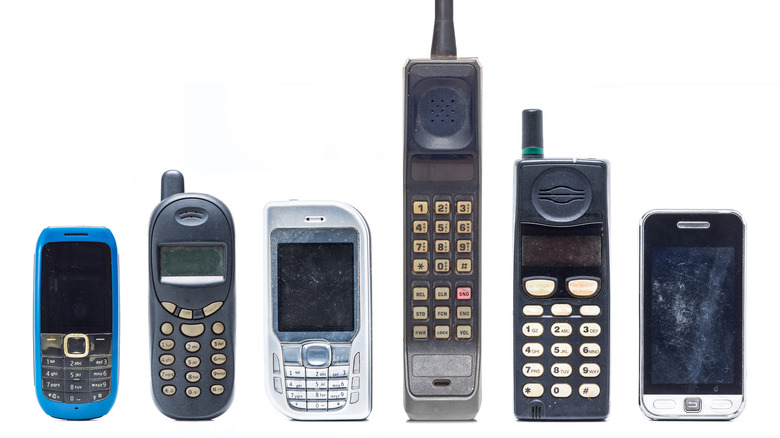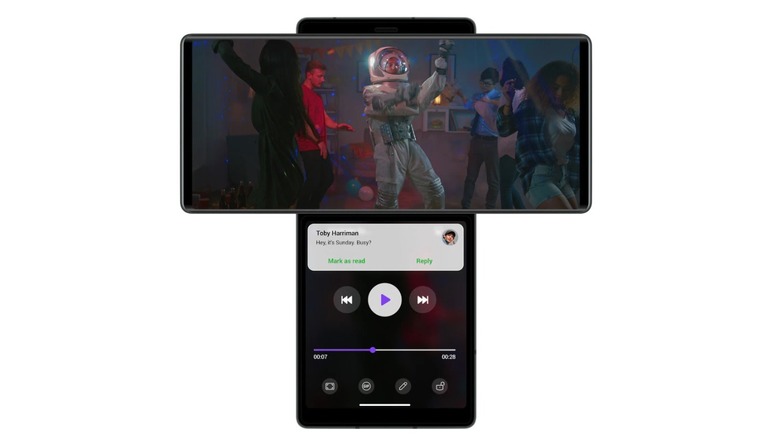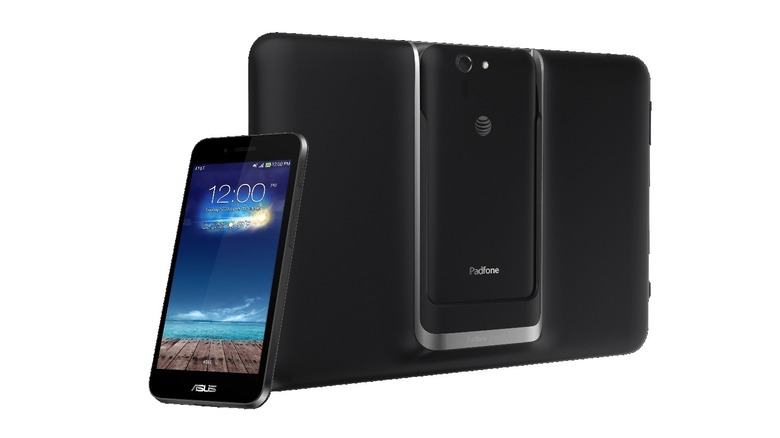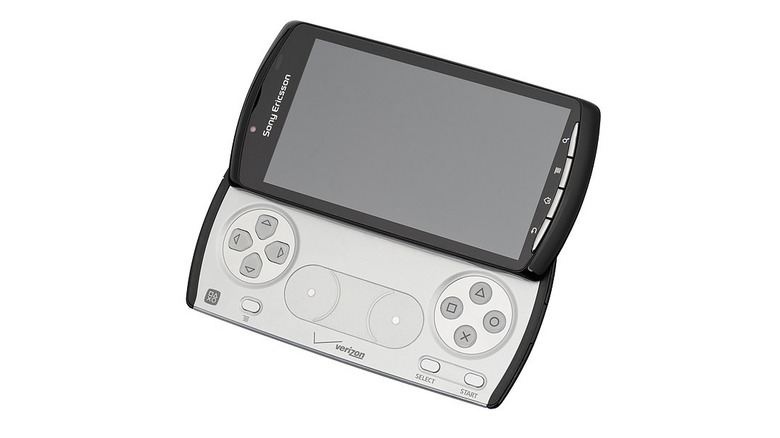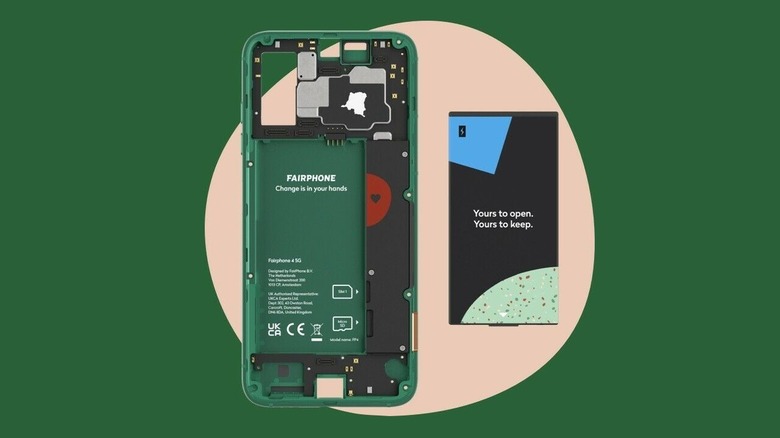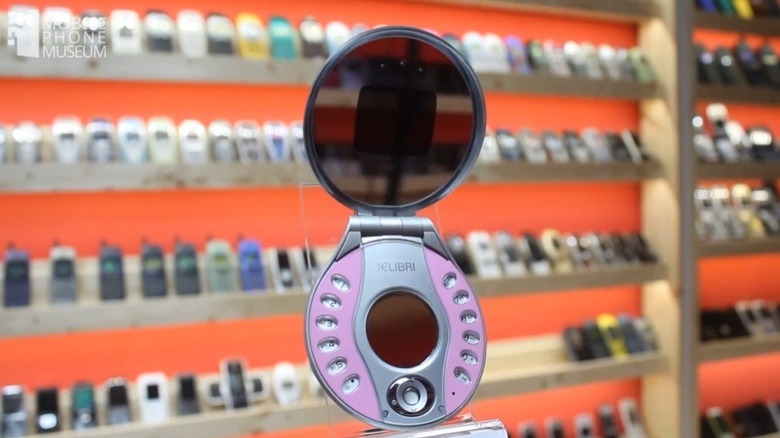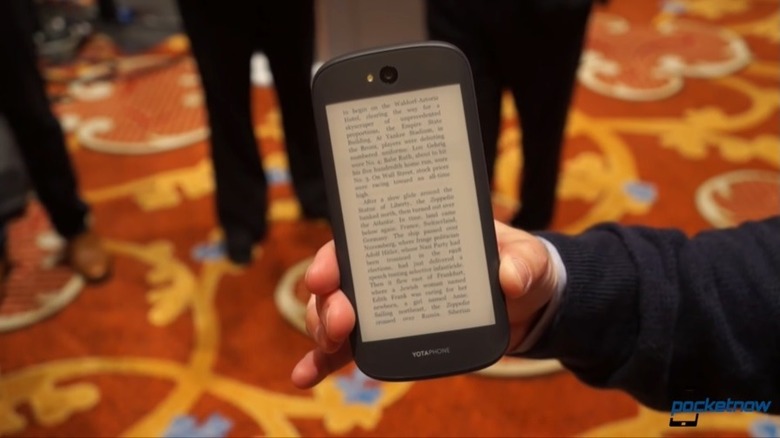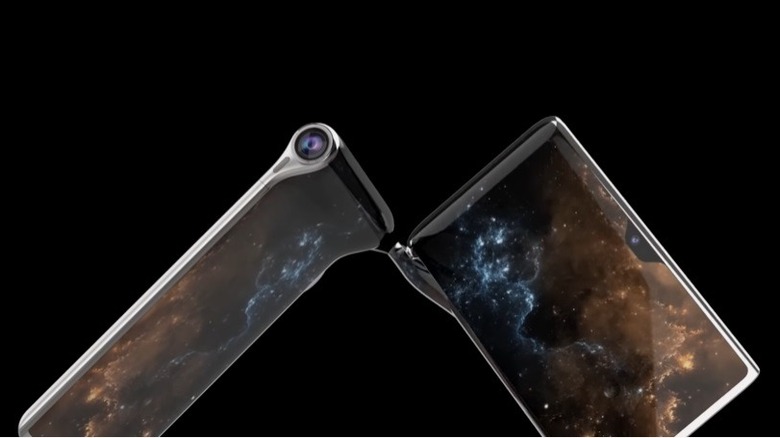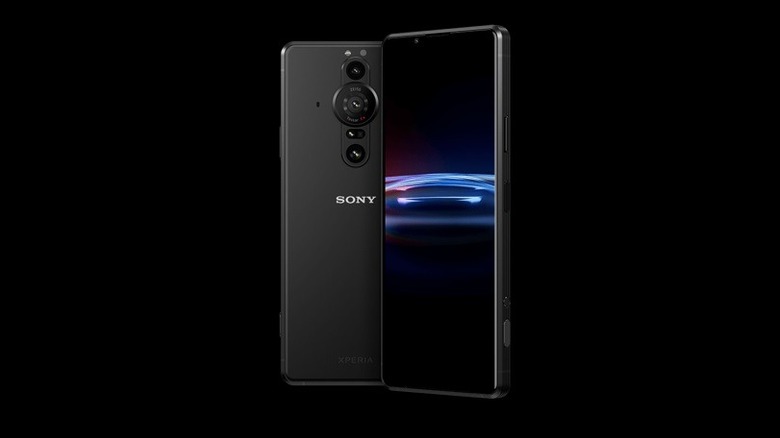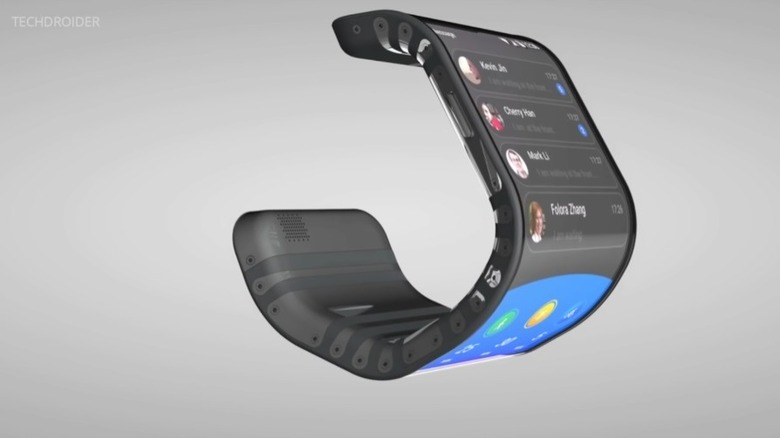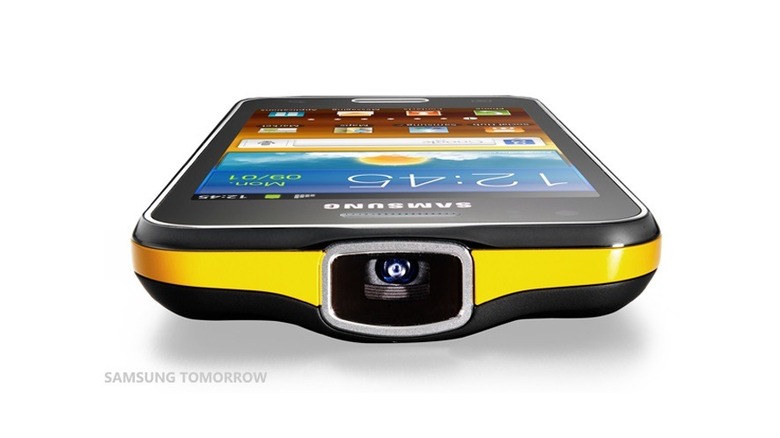10 Weird Phones That Are Surprisingly Cool
We may receive a commission on purchases made from links.
These days, most smartphones are interchangeable. Sure, each new generation has improved specs, upgraded processing, and a better camera, but they all more or less do the same things. Phones have, by and large, become vehicles for running applications. The phone itself is little more than a shell for sending messages and scrolling various social media feeds. If you and all of your friends tossed your phones down on a table and tried to pull yours out of the pile without inspecting them, it's likely you'd grab the wrong one. Such is the nature of today's cut and paste phone design.
One major difference, however, is in the phone's operating system, and for that, there are generally two camps. You're either an Android person or an iPhone person.
That's not to say that some phone manufacturers haven't tried to break the mold and craft truly unique devices. Sadly, most of them have fallen beneath the crushing boot of the status quo. If you want a truly unique phone experience, you might have to look a little further than your local wireless provider — and these ten phones are good place to start.
LG Wing
Dual monitors are increasingly common for home and office computers, but your smartphone typically only has one screen. If you're used to wielding several computer displays, each with its own applications running, then turning to your phone can feel a little like having one hand tied behind your back. Unless you're using the LG Wing.
At first glance, it looks like any other smartphone, if a little on the thicker side. But with the flick of a thumb, the primary screen rotates 90 degrees, revealing a second, smaller, screen underneath. The ability to suddenly do two things at once offers a lot of potential. You can use the primary screen to watch YouTube or Netflix while you scroll Twitter, send memes in the group chat, or answer emails on the secondary display.
That said, the second display suffers from its small size, rendering some content difficult to interface with, particularly if an onscreen keyboard is taking up much of the real estate. The primary reason for lackluster adoption appears to have been the lack of apps designed to work with the Wing's unique interface. In another universe, however, this is the best device on which to live out your dual-screen phone dreams.
Asus PadFone
The PadFone itself wasn't all that unique when compared to its contemporaries and, considering it came out more than a decade ago, it certainly pales in comparison to modern smartphones. In fact, as explained by Engadget, some of the design choices made it feel like a plastic toy when it should have felt like a robust piece of technology.
Where it really shone was in its unique ability to dock into a larger tablet. For a screen-addicted society perpetually switching between phone and computer, the PadFone offered the best of both worlds by taking two common devices and putting them together into one package.
The phone could be used independently, or it could slide into an accompanying tablet by way of a slot in the back. The phone then served as the brains of a larger device and the intuitive user interface automatically switched to accommodate the tablet display. Web sites, for instance, shifted from mobile to web versions and back again when you docked or undocked the phone. Additionally, because the phone maintained a 3G connection to your wireless carrier, the tablet benefited from a continuous network connection regardless of whether or not you were near Wi-Fi.
Despite a $200 price tag with a service contract, the market never embraced the PadFone, and it quickly faded into obscurity.
Sony Ericsson Xperia Play
Considering the ubiquity of mobile game play — there are an estimated 2.6 billion mobile gamers, according to Earthweb — it's surprising to learn that more companies haven't attempted to make a phone which plays double duty as a powerful gaming device. That said, if there was any company that could pull it off, it's Sony.
Perhaps the reason for the lack of smartphones capable of playing high-end games is that many prefer those experiences to remain separate, or are just waiting for the right device to come along. In 2012, Sony Ericsson hoped it had made that device with the release of the Xperia Play, which attempted to split the difference between a smartphone and a portable PlayStation.
Sliding the screen upward revealed a controller button layout, resulting in a device that looked like the technological lovechild between the T-Mobile Sidekick and a PSP. It also pushed the device automatically into gaming mode. Available games were shown in a scrolling list, but the available titles left something to be desired. That likely contributed to its ultimate failure to capture the market. A second version was planned for release (via Android Authority) with updated features including the potential for 3D gaming, but it was scuttled in the prototype stage before anyone could get their hands on it.
Fairphone
There was a time when getting into your phone for repair or replacement of components was relatively easy. Over the years, however, our mobile devices have been locked down into seemingly unbreachable casings. There are some benefits, of course, one being that it's harder for dust or moisture to get inside. But when something does go wrong that usually means sending your phone off to the manufacturer or replacing it outright.
The Fairphone bucks that trend by offering a modular phone that's easy to get into. Being modular, internal components can be easily replaced when damaged or dated without needing to replace your entire phone. It offers a potentially more affordable and less wasteful alternative than what's otherwise available.
Getting to the internal modules is as simple as unscrewing them, and the phone even comes with a screwdriver in the box. If something goes wrong, you can buy just the replacement module you need, rather than replacing the entire phone. What's more, the company is electronic waste neutral through a combination of recycling efforts and repurposing of old phones.
They guarantee five years of lifespan for your phone, pretty impressive when you consider that most folks replace their devices roughly every two years (via CNBC). Sadly, the Fairphone is only available in Europe for now.
Siemens Xelibri 6
The Xelibri 6 is truly one of the weirdest phones ever created. To look at it is to see something that does not look at all like a phone. The clamshell design more closely resembles a makeup compact or that cool eReader from "It Follows." In fact, the phone incorporated two mirrors, one of which had a magnifying effect, so that it could act, at least to a certain extent, as a beauty accessory. In fact, that's how the phone was marketed, as a combination communication device and fashion accessory.
George Appling, the president of Xelibri, believed that in the future, people would own many different fashion accessories, all of which happened to also make phone calls, and choose the one which best fit their outfit or mood on any given day (via Mobile Phone Museum). He might have grossly overestimated our willingness to own several different phones.
It lacked much of the functionality of an ordinary phone, as a combination of its design and the fact that it came out in 2003, but we can't help but wonder what other weird and wonderful devices we might have gotten if we nurtured this kind of creativity instead of the cookie cutter devices we commonly see today.
YotaPhone
The YotaPhone came out during a period of intense innovation in the smartphone arena. Smartphones had been ubiquitous for a decade and manufacturers were wondering how we might maximize the function of these devices we carried around with us all the time. The YotaPhone was born out of that innovation and while it didn't have much staying power in the market, in a parallel universe, it could have.
From the front, the YotaPhone looked a lot like its contemporaries, sporting a full-color LCD screen in 720p. Given that it was released in 2013, the rest of its specs, including its processor and 12MP camera were about as good as you could expect. Where things got surprising was when you turned it around.
Instead of the featureless backing you might expect to see, the YotaPhone offered a second display on the back side, but even it went in a weird direction. Instead of another LCD, it offered an eInk display well suited for reading comic strips, newsreels, and eBooks.
Certainly, every modern smartphone comes with the capability to run your favorite eReader apps, but they don't offer the same strangely calming experience that eInk does. The YotaPhone's unusual dual-screen display made it a combination smartphone and Kindle Paperwhite without sacrificing the functionality or convenience of either.
Turing HubblePhone
Turing, named for the famous mathematician and computer scientist, has had a troubled run developing and releasing smartphones. Several attempts crashed on the runway but in 2018, shortly after filing bankruptcy, the company made a final (at least so far) attempt at releasing a phone — and it was a doozy.
The HubblePhone, named after the famed space telescope, had a three-screen clamshell design that allowed one of the screens to swivel out in various directions. The unique design meant that it could be used in a number of configurations, including something resembling a laptop and a handheld video camera. It also boasted a frankly ludicrous number of high-end functions including artificial reality, AI, and mobile game console capabilities, just to name a few.
At the time of its announcement, the HubblePhone was little more than a prototype set for release in 2020. Like previous efforts from Turing, the HubblePhone never manifested, but if the concept images were any indicator, it might have been a game changer. Although, it would have set you back $2,749 for the privilege. Here's hoping the brand's next effort, if there is one, is more successful.
Sony Xperia Pro-I
While smartphones are generally used for communication and web surfing, there has long been a focus on their cameras. Each time a new phone comes out, one of the biggest selling points is an improvement in the imaging quality, with most phones boasting increased megapixels as a key feature. That makes sense, considering that social media insists we document every moment of our lives, and one of the central ways we do that is through photography.
That said, many of the images we put online have been doctored in some way and phone manufacturers have leaned into that. While the physical camera has increased its ability to pick up light and detail, the processing software allows you to easily modify your images through features like night mode and built-in filters. The Xperia Pro-I takes another approach.
The combination of a 12MP camera and a 1.0-inch Exmore RS sensor makes for a powerful combination but Sony but the real secret to its appeal among photography enthusiasts is in the processing. Taking a cue from Sony's successful camera lineup, the processing promises photos that look like the real thing (via Tech Radar) intended more for a gallery than for Instagram. If you're looking for a solid camera that happens to make calls, as opposed to a phone that also has a camera, this might be for you.
Lenovo C Plus
The C Plus, from Lenovo, is so far only a prototype, and considering that it was announced in 2016 it might remain that way. It takes the relatively recent interest in bendable phones to an aesthetic extreme. When in its normal configuration, it looks like an ordinary smartphone if a little gangly. The secrete behind its unique design is a series of ridges along the back, each of which serves as a point of articulation.
When bent along those points the phone curves into something resembling the letter C, hence the name. It's enough to mold the phone around your wrist like the slap bracelets of yesteryear. According to Phone Radar, the prototype still had some bugs to work out before it could hit store shelves, however.
At demo time, bending the phone caused the screen to crack and spots on the display stopped working. While an image could still clearly be seen on its surface, the busted pixels and strained display leave much to be desired. Lenovo hoped that improvements in flexible display materials might bridge the gap, delivering a device that is at once a phone, smartwatch, and fashion accessory. Whether or not this idea ever comes to fruition remains to be seen, but we can hope.
Samsung Galaxy Beam
Samsung's Galaxy lineup of phones has a well-known pedigree, having been a mainstay in the mobile phone arena for more than a decade. In 2012, the company decided to take a risk by incorporating a built-in projector at the top of the phone, resulting in the Samsung Galaxy Beam.
Back before you could easily cast content to your TV, the Beam offered the ability to transfer your content from your phone to a wall or projector screen. Watching videos or viewing images could easily become a shared experience with applications in the home and the workplace.
The projector boasted 640x360 pixels which, while not movie theater quality, was still a fun addition and good enough for many applications from the office to your weekend parties. That said, the Beam had a relatively small audience. While projectors are fun to play with, most of us don't need one in our pocket at all times. It also might have suffered as a consequence of being before its time. Given advances in phone, battery, and projector technology, it's primed for another attempt. Bring on the portable pocket projector. The world could use more phones that take risks and get a little weird.
